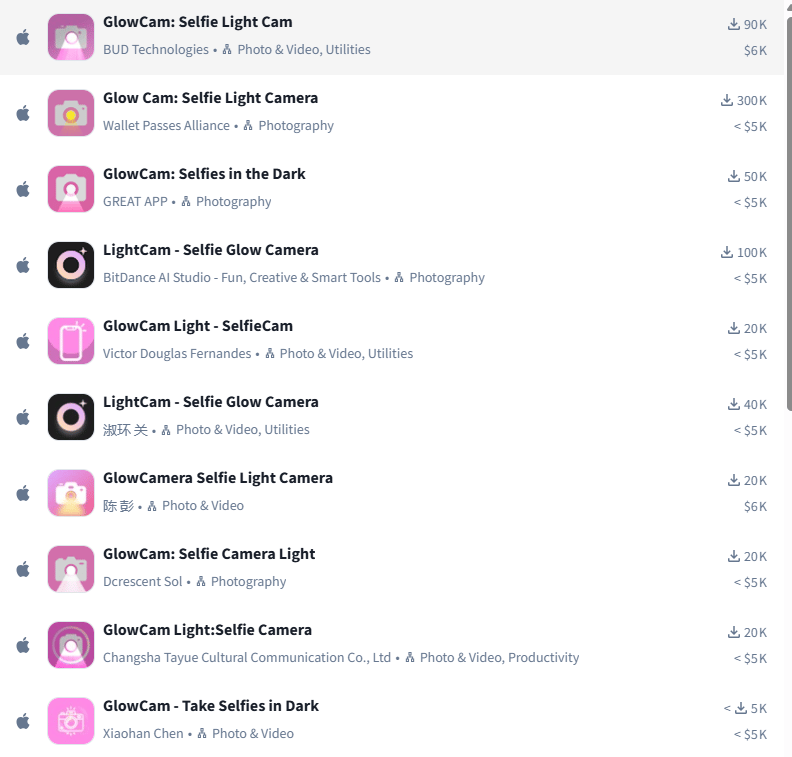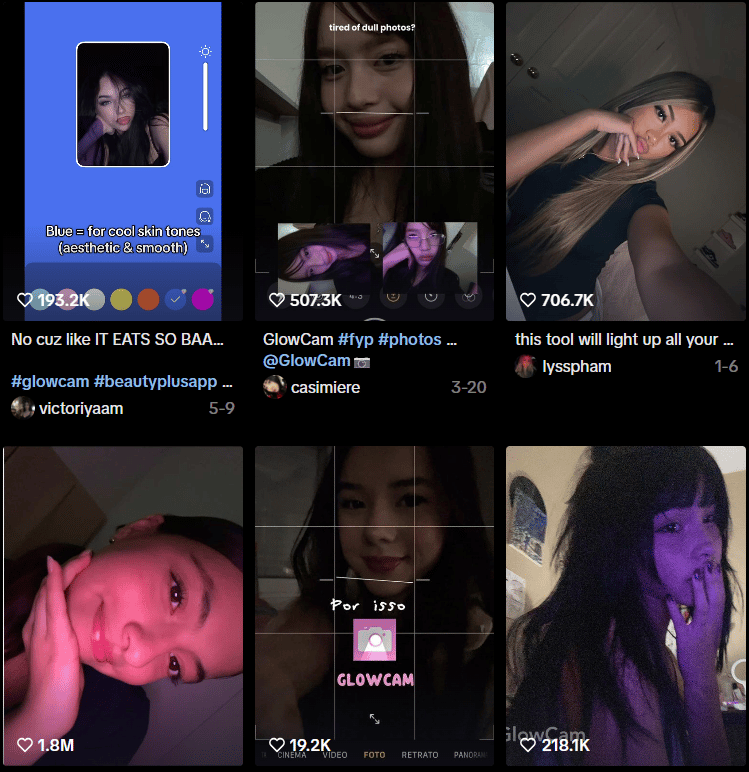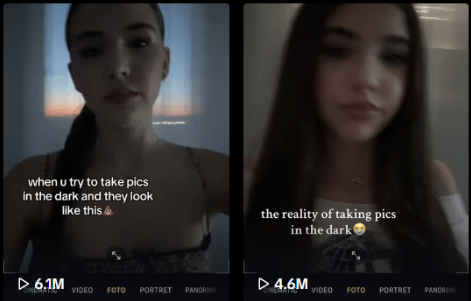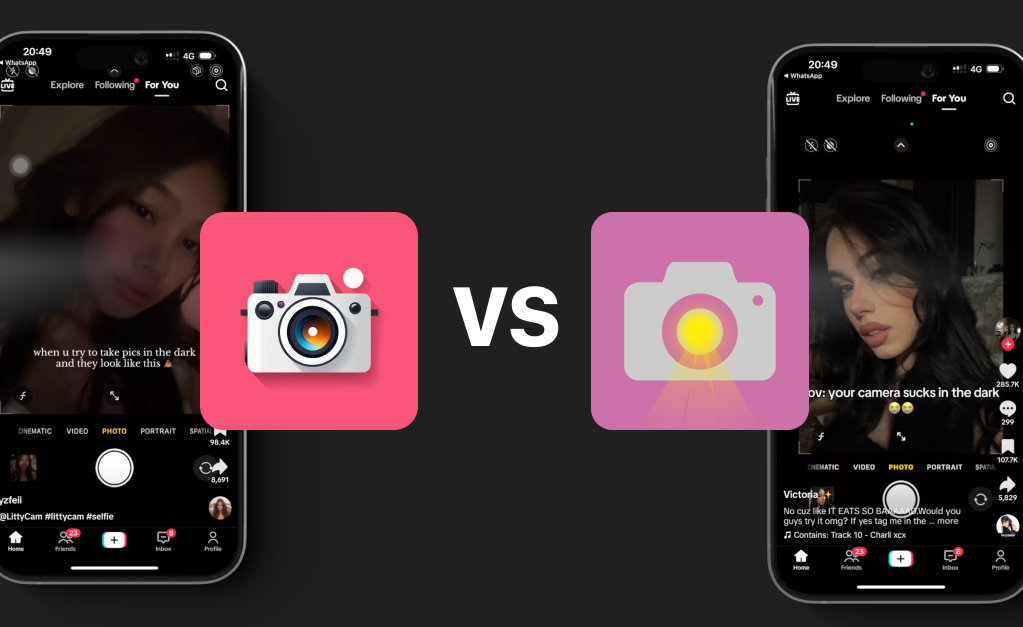It’s every new founder’s nightmare.
Picture this: you launch a hit app, it explodes across TikTok, monthly recurring revenue (MRR) soars, and downloads roll in… only to watch someone lift your entire playbook only a few months later, line by line.
They copy your idea, mimic your distribution tactics, and somehow manage to do it cheaper and faster.
That’s, in short, the story of GlowCam versus LittyCam.
From Breakout to Facing Copycats
Back in late 2024, GlowCam was the “selfie light” app; it was at the top of everyone’s FYP. Fast‑forward to 2025, and a look‑alike app called LittyCam has joined the chat.
Last month alone, LittyCam chalked up 70K downloads, coming dangerously close to GlowCam’s 90K.
Same concept. Slightly tweaked name. Nearly identical features.

What happened? Did the copycat out-market the original?
Is this a case of better branding, smarter distribution, or just pure luck?
Let’s break it down and see what practical lessons founders can learn and apply, from both sides:
GlowCam’s paid-partnership playbook
GlowCam, built by BUD Technologies, was one of the first apps to brand itself as a “selfie‑light enhancer.” Released in December 2024, it skyrocketed on the charts. But now, it seems its momentum has been slipping:
• Just three months ago, it ranked #144 in the U.S.; today it hovers around #416.
• In Mexico, it fell from the Top 20 to #83 over the same stretch.
Even with the slide, GlowCam still leads the pack on revenue at roughly $6K MRR, but lately others have started to catch up…
Glow Cam: Selfie Light Camera (yes, that’s a different app) tallied 300,000 downloads to GlowCam’s 90,000 last month. And it was launched in 2025.
Take a look at the sheer number of “Selfie Light” apps:

How the original strategy worked
GlowCam’s TikTok strategy was simple:
1 Partner with “pretty‑girl” influencers.
2 Single video formula: before/after selfies showing how dramatic the lighting improvement looks.
3 Content in English and Spanish to widen reach.

With just 37 UGC posts, GlowCam racked up 66.4 million views, 2.3 million bookmarks, and 214,000 shares. Most of those viral peaks happened early in 2025.

But they kept running the same pitch and video style, so their buzz faded while copycat “selfie‑light” apps started to appear:

It’s a solid strategy, a proven format… but now it’s there for anyone to take.
How LittyCam came after GlowCam
1. “Stole” their best creators
When LittyCam hit the App Store, they didn’t just copy GlowCam’s video style—they hired the same influencers who’d already made GlowCam’s ads go viral.
Same faces, same hook, new call‑to‑action.
The video structure barely changes: a girl struggles to take a selfie in poor lighting, taps LittyCam, and that’s it. Perfect selfie.

Example: A LittyCam video uploaded on March 24th has already pulled 6.5 million views. The GlowCam original, posted a month earlier, sits at 4.6 million views.
Hooks are (almost) the same:
| LittyCam | GlowCam |
| “when u try to take pics in the dark and they look like this ????” → 8M views | “Hiii, day 2 of beauty tips“ (spanish) → 16M views |
| “tired of dull photos?” → 5M views | “Boring and colorless photos with your cell phone camera?” (spanish) → 10.9M views |
| “taking aesthetic pictures in the dark?” → 2.8M views | “tired of these dark and blurry photos on your phone?” → 7.2M views |
| “stop taking your picture in the dark like this” → 1.1M views | “tired of dull photos?” → 5.7M views |
| “how to take selfies in dark areas ✨” → 600K views | “the reality of taking pics in the dark” ???? → 4.7M views |
2. Price undercut (like, a lot)
GlowCam’s pricing is brutal:
• $70 per month
• $180 per year
• $300 lifetime
That’s a lot considering they’re just selling selfie lights to young (wannabe) female influencers.
By contrast, LittyCam charges $8 per year or $13 lifetime. Same value, 95 % cheaper. Because there’s no data or streaks to lose — like a language or journaling app — users switch in a heartbeat.
The impact was felt straight away. Three months ago, GlowCam reported $9,000 MRR and 200,000 monthly downloads. Today, its MRR has dropped by roughly two‑thirds, and downloads are down 55%.

3. Less durable distribution moats
GlowCam’s only edge was being first. The app is basically a single‑feature utility (no social feed, no user data to lose, no streaks, no community).
That means there’s nothing keeping users (or creators) loyal once a cheaper clone shows up.
They also never turned their one‑off UGC deals into an exclusive ambassador program or offered rev‑share to lock influencers in. As soon as their TikTok format proved it could move installs, new competitors arrived, including BeautyPlus. Despite being an AI photo editor, recently it also tapped into the selfie light use case:
| BeautyPlus : “POV: your camera sucks in the dark ????” LittyCam : “When you try to take pics in the dark and they look like this ????” |
| both videos from May 2025 |
BeautyPlus cross‑promoted to its existing user base; LittyCam mirrored GlowCam’s UI, pricing, and sounds. With no built‑in switching cost, GlowCam had no way to fight back at scale.
Don’t make the same mistake…
Virality puts you on the map fast, and it’s incredibly powerful to kick-start your distribution… but it doesn’t automatically translate into long‑term advantage and retention.
GlowCam nailed the viral bit, but missed the follow-ups: retention hooks and defensibility in large-scale/recurring distribution.
What GlowCam should have done (and can still try):
• Build a large-scale ambassador program. Lock in creators on retainers, or with revenue share, exclusive content, or affiliate codes, so they don’t jump ship. This creates “volume” defensibility that makes it hard to compete. Apps like Airbuds and Locket, and many study apps have already achieved this.
• Intensify the scale of influencer promotion. Follow the same approach: build relationships and own the space or vertical as the “TikTok” app for this use case, just as Cal AI and others have done.
• Diversify content styles. Move beyond polished influencer promos. Try:
• Meme-style content about bad selfie lighting to inject humor and relatability.
• Lifestyle videos: creators casually shooting high‑quality selfies in real low‑light settings.
• Behind‑the‑scenes clips showing how the lighting works.
• Split‑screen comparisons that look realistic, not staged.
GlowCam handed LittyCam the blueprint and the incentive: a viral format and an overpriced product
In this new era of low-cost software production and apps, originality is less defensible. Distribution is crucial, yet easily cloned. You’ll need to stay ahead at every stage with a better product and better distribution.
Having consistent daily views and predictable recurring breakout videos is where you win.
It is a never-ending rat race.
See you next week,
—The Social Growth Engineers Team

Leave a Reply